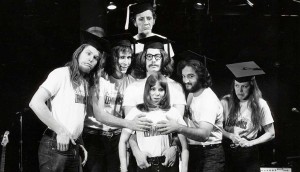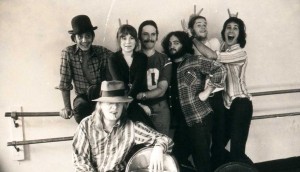
Everyone knows the names: Belushi, Chase, Murray. Everyone knows the show: Saturday Night Live. Everyone knows the films that followed: Animal House, Caddyshack, Ghostbusters. But few contemporaries might know their collective comedy origins: a New York-based magazine called The National Lampoon.
With exclusive access to the magazine’s archives plus key interviews with many of the living principals, director Doug Tirola set out to show The National Lampoon in all of its over-the-top glory in his new documentary, Drunk Stoned Brilliant Dead, starting in small doses at Harvard then capitalizing as a legitimate effort by the end of the 1960s. The Lampoon went on to rule the 1970s, publishing outrageous envelope-pushing photo-laced articles, skewering the politics and social movements of the day, and bringing forth nascent comic talent at every level. At its heights, The Lampoon presented stage and radio shows, albums, and never stopped churning out subversive, groundbreaking print material.
Nonetheless, when Tirola set out to immortalize the impact of The Lampoon in a self-contained documentary, he knew that his approach and stylistic methodology would have to be as unique as its subject matter. “They didn’t want me to make a greatest hits film where you are showcasing stuff, and there’s not really a story,” Tirola said.

Surely, one of the challenges of amassing a documentary about an established magazine is combing through the droves of individual pages of back issues, in addition to locating archival film footage, stills and shooting new interviews. “A lot ended up in the movie that was stuff I had loved when I was younger,” Tirola said.
As with any in-depth documentary, much less one about a pioneering place of business, Tirola and his team required special access to the people and materials housed in The Lampoon’s New York offices. “We had to be able to go through those magazines and find something that worked,” said Tirola. “What makes you really feel immersed in the Lampoon world is we have stuff in there, capturing the essence of the mag. When you do a present-day story, you get your subjects to agree. They help you get other people. Meeting people, they put in the good word for us. I would equate this film like getting well-known actors to take part in an independent film.”
Shooting interviews took place over six months, followed by a 10-month editing period spread over the span of over three years while Tirola filmed material for another project. In the editing room, Tirola began to discover his Lampoon narrative. “I think the Lampoon is part of the foundation of contemporary comedy,” he explained. “Many of the key people at SNL both onscreen and off came from the Lampoon. What might be overlooked [that] was also important is the aesthetic of the Lampoon – the look of the magazine. For shows like Carol Burnett, Laugh-In, Flip Wilson, the art direction looks like an MGM musical. They are inferring something. At the magazine, everything had to start to look real. All of those people who worked there brought that with it.”
In addition to Saturday Night Live, Animal House brought Lampoon figures to the forefront of creative activity, including Lampoon co-founder, the late Doug Kenney. “Animal House creates its own genre really,” said Tirola. “So many films borrowed from the movie – the gross-out, toga party, food fight, girl’s sorority. People’s recollection tends to focus on those ideas, and they tend to forget about the humor synonymous with the magazine: the race relations; making fun of upper middle-class white kids who think they have a bond with African Americans.”
 Now over 45 years old, The Lampoon’s influence is still being felt, and, as such, Tirola also targeted younger audience members with his film. “You want them to know the story,” he noted. “When Green Day first came out, they owed a lot to the Clash. In that same way, you want people who love Judd Apatow movies to know, this is where it began. Look at the talent that was there and how they did things. I love this idea of a bunch of people coming together who would not have been friends in any other circumstance of their life to do something really special. This story is an example of that. Somebody took the smartest person from each of those cafeteria tables in high school, and this amazing stuff happened.”
Now over 45 years old, The Lampoon’s influence is still being felt, and, as such, Tirola also targeted younger audience members with his film. “You want them to know the story,” he noted. “When Green Day first came out, they owed a lot to the Clash. In that same way, you want people who love Judd Apatow movies to know, this is where it began. Look at the talent that was there and how they did things. I love this idea of a bunch of people coming together who would not have been friends in any other circumstance of their life to do something really special. This story is an example of that. Somebody took the smartest person from each of those cafeteria tables in high school, and this amazing stuff happened.”
In the end, Tirola hopes that Drunk Stoned Brilliant Dead unearths the magic of The National Lampoon for both longtime fans and the aforementioned new audiences who might never have experienced rabid counter-culturalism as overtly in media as it was at The Lampoon in the 1970s.
Drunk Stoned Brilliant Dead: The Story of The National Lampoon is currently playing theatrically on the art house circuit and is already available on iTunes and Vide OnDemand.





